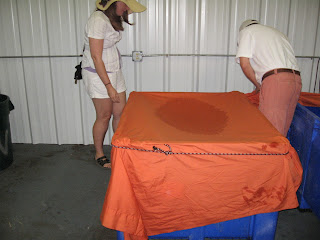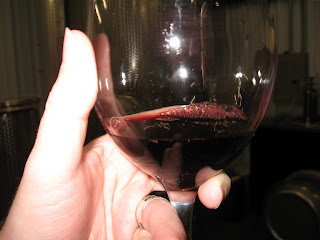Right now, harvest is in full swing -- Bending Branch's Tannat was harvested last week. When I log onto Facebook or Twitter, my newsfeeds are dominated by harvest news and pictures. Despite the scorching heat and odd weather, it seems to be a magical time here in Texas. And as the grapes leave the safety of the vine, they begin a more wondrous journey. The creative aspect of wine is at the forefront, as wine makers begin the process of turning grapes into a magical elixir. At Bending Branch, they continue with their hands-on development as the wine-making stage begins.
 |
| De-Stemmer | |
And these next steps are crucial. At Bending Branch, they don't have a normal crush, de-stemming and crushing the grapes before fermentation begins. After harvesting, they de-stem the grapes but not crush them. Instead, the juice and whole grapes are generally left intact to ferment. Bob Young explained that starting the fermentation in the berry helps to bring out more of the flavor. And if there is one thing Texas wines are good for it is their complexity and depth of flavor.
 |
| De-Stemmed Malbec |
The fermentation process continues once the grapes are placed in their bins. To do this, an individual will press the grapes by hand three times a day. Using a press, the individual will press down on the grapes, sending the grapes down and the juice up. This process can increase alcohol content quickly. When we were visiting, the Malbec I had the chance to hand-press had already increased in alcohol content in only three days. Now, this process seems time consuming -- and it is -- but Bob explained how it aids fermentation. During fermentation, the grapes release CO2. The hand press actually helps to release it from the grapes and juice, aiding the process along while maintaining more of the grapes' flavor.
 |
| Malbec being hand pressed |
The CO2 by-product of the fermentation may need to be released from the grape, but it is still useful in the process. If a layer of CO2 covers the grapes and juice, oxygen cannot get to the grapes. This is something that is not wanted. Oxyidation hurts the wine -- no one wants vinegar that early in the process. But worst of all, oxygen breeds bacteria. By keeping a layer of CO2, the fermenting grapes stay bacteria-free. At Bending Branch this is done very simply. Every bin is covered by a cotton bed sheet that is kept in place by bungee cords. Right after the pressing, when the the CO2 is released, the bins are covered, sealing the CO2 in, and the layer of CO2 and bed sheet help to keep the oxygen out.
 |
| Covered bin to seal in CO2 |
The final stages at Bending Branch are also inertesting. I have read blogs about barrel rooms that are stacked high -- Jeff Cope recently found out that Messina Hof has 800 filled barrels. Well, there weren't that many here, but the long rows of three to five barrels high and seven deep provided a good view of what is coming at Bending Branch (if this year's harvest is any indication, they will have more barrels). At Bending Branch, they have a preference for American oak because of the tastes that the oak brings to the wine. I did notice a number of French oak barrels and found out that they were actually secondhand; I was also told they have some Hungarian oak too.
 |
| Barrel Room |
But there is more to barrel aging than the wine resting in a barrel for a specific number of months. An interesting fact I learned was the need for topping. Over time, the wine in the barrel will decrease. The remaining space, unfortunately, becomes a nice haven for the oxygen (and then we have oxydation and bacteria issues again). To make sure the barrels stay full, there is wine kept aside for topping off the barrels. At Bending Branch, they rely on used Anheuser-Busch kegs to hold the wine that is used for this. I am not much of a beer drinker, so I am all for using kegs for wine.
 |
| Kegs filled with wine for barrel topping |
After the barrel aging is complete, the wine is hand botttled at Bending Branch. Their simple system starts with putting nitrogen in the bottles to prepare them for filling. Then the bottles are taken over for filling. Here, they can do five bottle at a time. When we visisted Texas Legato back in May, they could only do two at a time. This five-bottling system was a big step-up. Also at Bending Branch, they had machines to help with other steps, such as putting in the corks, sealing the bottles, and labeling. Again, this is an improvement from what we saw at Texas Legato; there, a single peson used very simple equipment to do one bottle at a time (and they put the labels on by hand, no machine). However, bigger operations have them dwarfed. Bob mentioned that the machines used by bigger operations start at about $300,000; a reason they chose this more simplistic system. I have seen smaller versions of this. At Becker vineyards in the barrel/tasting room and Duchman in Dripping Springs, they have the more fully automated systems. These systems rely on a conveyor belt to move bottles along the process (from preparing the bottle to labeling). At Bending Branch, the convyer belt is the people that run each machine lined up together.
 |
| Bottling machines |
And when all this is said and done, award-winning wine is produced. To be honest, Bending Branch is one of those wineries where I can say I like every wine. Learning about their process, their dedication, the time, and the passion they put into each and every grape and bottle explains why. I hope things stay this way at Bending Branch; their hands-on approach produces wine of incredible quality.
 |
| Straight from the barrel: Texas Tannat |








No comments:
Post a Comment